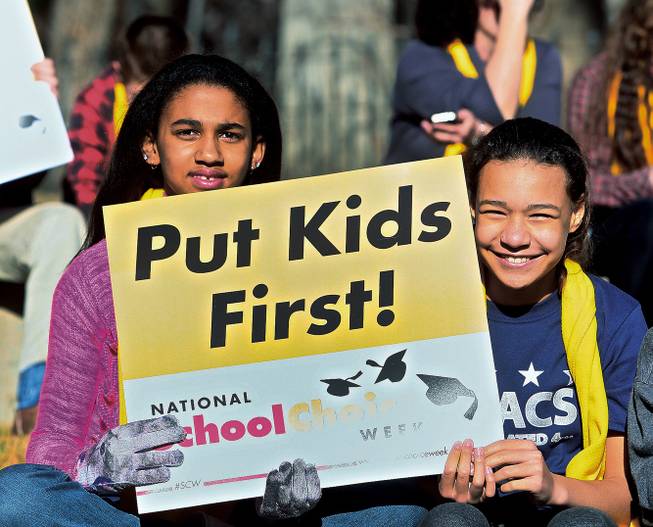
Brad Coman / Nevada Appeal / AP
Students Isabel Onisile, 11, and Octavia McKindra, 11, attend a rally at Sierra Nevada Academy Charter School at the National School Choice Week Capitol celebration Wednesday, Jan. 28, 2015, in Carson City.
Wednesday, Oct. 5, 2016 | 2 a.m.
The Nevada Supreme Court’s ruling last week to put the state’s controversial education savings account program on permanent hold made for some interesting political theater.
Supporters of the program hailed the decision as a victory for the cause of school choice. At the same time, opponents said the ruling was key to preventing similar programs from being enacted across the country.
The passion of the moment, however, is now giving way to the political reality, namely: Where does the most sweeping school-choice program in the nation actually go from here?
The 30-page ruling by the high court is complicated, but here’s the short version: the ESA program is constitutional, but the Legislature can’t use money earmarked for public education to fund it.
That’s a major blow to the Nevada program, which aimed to allow qualifying families to use what the state pays to educate their students in public school to instead pay for things like private school tuition.
The pressure now falls squarely on the shoulders of Nevada’s politicians to find a different way to finance the program, and it won’t be easy.
One of the central arguments in favor of education savings accounts nationwide has been that states already allocate a certain amount of education funding per student, and that families should be able to choose where that money is spent.
But if ESAs are not allowed to use money already allocated for education, it's unclear where the money will come from.
"We are confident that the Legislature will find a way to fund this invaluable program so the 8,000 children who have applied will be able to utilize the options that they need," said Hergit Llenas in a statement.
Llenas is a director for the Nevada School Choice Partnership, one of the local grassroots organizations that popped up after the ESA program was approved by a Republican majority last year.
They aren’t the only group. Michael Chartier is a state policy director for the Friedman Foundation, which champions applying free-market ideals to education policy. The organization has been helping to roll out similar programs in a handful of other states, and Nevada has been a focal point.
“It’s going to require a lot of work on a lot of people’s parts,” he said. “I think ultimately they’ll find a way to fund it.”
But opponents say it’s a tough sell. They say politicians are going to have to either raise taxes to provide for the program, or take the money from elsewhere in the state budget.
“[The ruling] forces the Legislature to rethink whether this is the wisest investment of public funds,” said Sylvia Lazos, a UNLV law professor and policy director for anti-ESA group Educate Nevada Now.
It will also force lawmakers to decide whether it makes more sense to divert money to an ESA program rather than other education programs. For instance, Lazos brings up funding for preschool.
One 2005 study put the cost of funding preschool for Nevada’s low-income students at around $40 million, which is comparable to the cost of funding ESAs for the roughly 8,000 families who have applied.
“Pre-K is a much better investment of our public dollars than a voucher program,” Lazos said. “At least for low-income students, going to private school is not a solution.”
In the aftermath of the ruling, a number of Republican lawmakers who support the program have stated publicly that they plan to figure out a way to fund it, even calling on Gov. Brian Sandoval to include the issue in a forthcoming special legislative session to review a proposal to build a stadium for the Oakland Raiders in Las Vegas.
But they remain tight-lipped on the funding problem. Republican state Sen. Scott Hammond, who authored the bill creating the ESA program, said Tuesday that he “and a lot of other people” were already working to draft a legislative fix, but didn’t offer specifics.
Until lawmakers come forward with specifics and a timeframe for addressing the issue, it’s back to limbo for the thousands of families waiting to take advantage of the program.
“We need to get them those options and access to those funds,” said Chartier. “We would be behind anything that made those options available as quickly as possible.”
Sun reporter Cy Ryan contributed to this story.

Join the Discussion:
Check this out for a full explanation of our conversion to the LiveFyre commenting system and instructions on how to sign up for an account.
Full comments policy